| Columns Retired Columns & Blogs |
"Hello, Star Trek Enterprise here ........... How can we help you?"
"Ahoy ahoy, Alexander Graham Bell here .......... Beam me up Scotty"
Like Rega Research's Apollo CD player, which Art Dudley reviewed in June 2018, the Kalista DreamPlay One has no digital inputs of any kind, which limited my measurement of its technical behavior to using 16-bit test files burned to a CD-R. I tested the Kalista with my Audio Precision SYS2722 system (see the January 2008 "As We See It"), using two of the six reconstruction filters the Kalista offers: AD's preferred filter, the Super Slow Rolloff, and the default filter, Sharp Rolloff.
The Kalista's error correction was good—no interruptions were apparent in the player's output until the single gaps in the data spiral on the Pierre Verany Digital Test CD reached 1.25mm in length, when there were occasional glitches. (The Compact Disc standard, the so-called "Red Book," requires that a player cope with gaps of up to 0.2mm.) With the Kalista's output set to "2.5V," which is how AD auditioned the player, the maximum output level from the unbalanced output was 2.46V, which is 1.8dB higher than the CD standard's 2V. As expected, the maximum balanced output level was twice the unbalanced, at 4.92V. Both outputs preserved absolute polarity (ie, were non-inverting). The unbalanced output impedance was a very low 20 ohms across the audioband; the balanced impedance was 40 ohms, again at all audio frequencies.
Fig.1 shows the DreamPlay One's impulse response with AD's preferred reconstruction filter, the Super Slow Rolloff: it is a perfect impulse, with no pre- or post-ringing. With the default Sharp Rolloff filter, the impulse response (fig.2) was typical of a linear-phase filter, with ringing either side of the peak, though the undershoot before the single sample at 0dBFS is larger than that immediately after. Tested with white noise sampled at 44.1kHz, the Kalista's output with the Super Slow Rolloff filter began to roll off in the top audio octaves and exhibited a slow decline in output at ultrasonic frequencies, with nulls at 44.1kHz and its harmonics (fig.3, red and magenta traces). The aliased image at 25kHz of a full-scale 19.1kHz tone (blue and cyan traces) is hardly suppressed at all, though the harmonics of that tone are well down in level. With the Sharp Rolloff filter, the output rolled off quickly above 20kHz (fig.4, red and magenta traces), and the aliased image at 25kHz of a full-scale 19.1kHz tone (blue, cyan) is suppressed by >100dB.
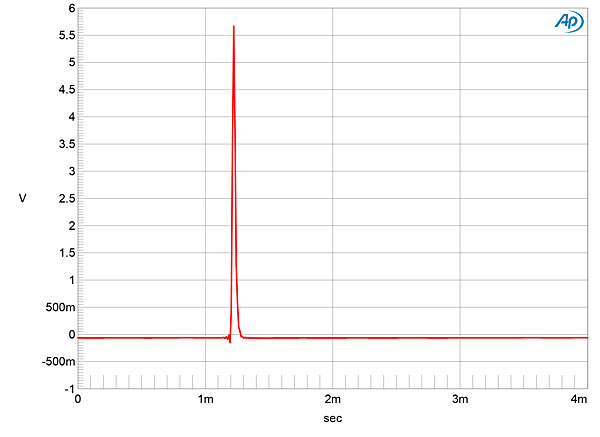
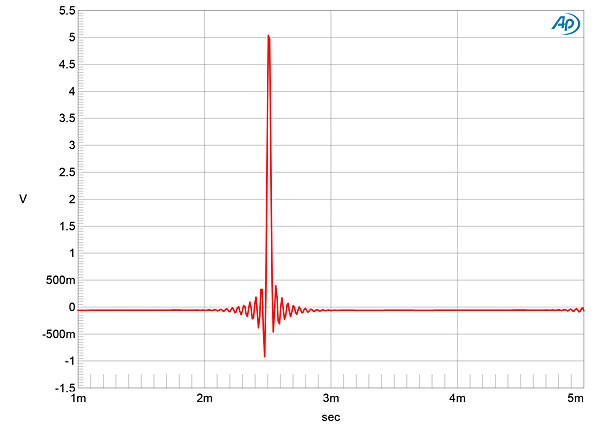
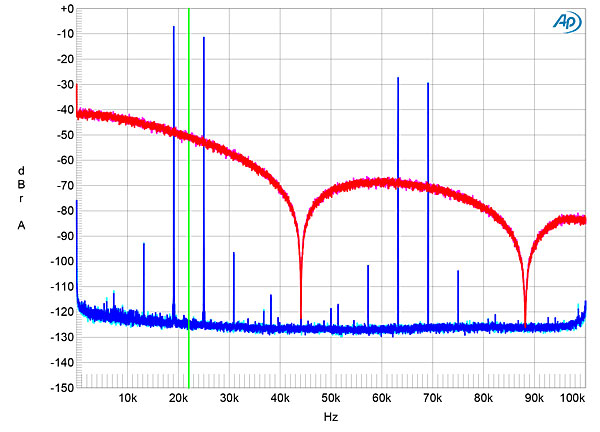
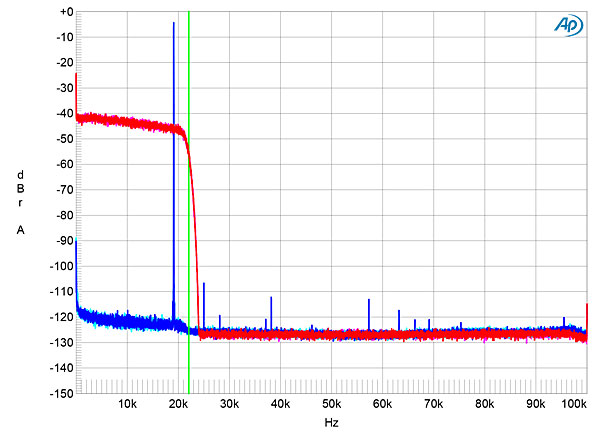
The blue and red traces in fig.5 show the audioband response, taken with spot tones, of the Kalista with the Super Slow Rolloff filter; although this graph reveals excellent channel matching, the response begins to roll off above 2kHz, reaching –3dB at 12kHz and –6dB just below 20kHz. The audioband response with the Sharp Rolloff filter rolled off almost as quickly, reaching –3dB at 15kHz. This behavior, which will add some "sweetening" to the Kalista's sound, explains why AD found the audible difference between these two filters to be very subtle: in the frequency domain, they behave almost identically below 20kHz. The cyan and magenta traces in fig.5 show the response with preemphasized data: the output above 1kHz is suppressed by an additional 1dB. Fortunately, preemphasized CDs are extremely rare.
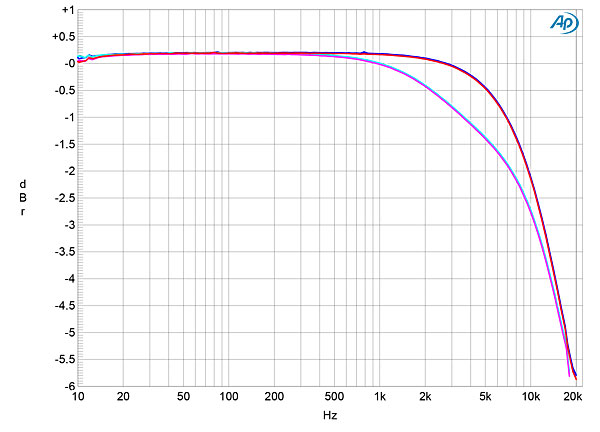
Channel separation (not shown) was superb, at >100dB in both directions below 1kHz, decreasing to a still-excellent 83dB at 20kHz. The analog noise floor was low in level (fig.6), but power-supply–related artifacts can be seen at 60Hz and its odd-order harmonics. (The limited space in my test lab meant that I had to place the Kalista atop the Electra power supply, but I did raise it 6" to try to minimize magnetic interference. I tried both positions of the Electra's grounding switch with no significant changes.) Peculiarly, the spectral spike that represents the 1kHz tone in this graph shows some spreading at its base.

With dithered data representing a 1kHz tone at –90dBFS (fig.7), the level of the tone is correct, but the graph actually shows the spectrum of the dither noise used to encode the 16-bit test signal. With the Super Slow Rolloff filter and undithered data representing a 1kHz tone at exactly –90.31dBFS (fig.8), the waveform is symmetrical and the three DC voltage levels described by the data are well defined, but with very slight DC offsets in the two channels.
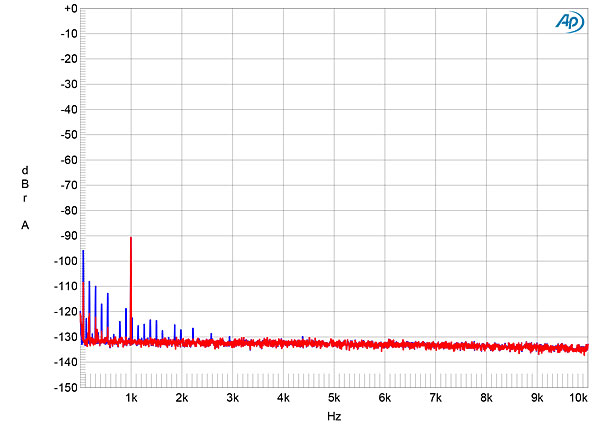
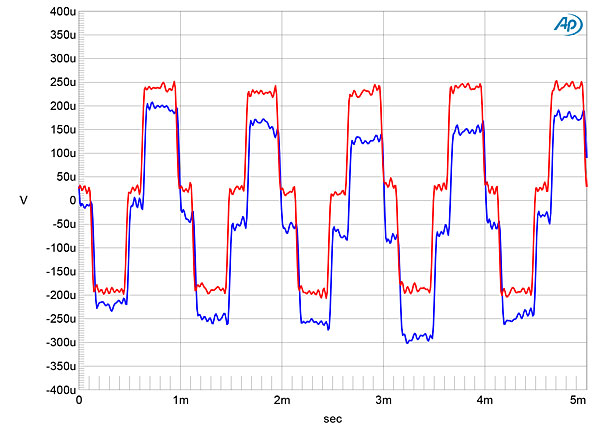
The spectrum of a full-scale 50Hz tone into 600 ohms (fig.9) indicates that, even into this demanding impedance, the distortion is low in level. The DreamPlay One's distortion signature is dominated by the second harmonic at –84dB (0.005%) and the third harmonic at –90dB (0.003%), but the spectral spreading seen in fig.6 can still be seen. I then tested the Kalista and the Super Slow Rolloff filter for intermodulation distortion with an equal mix of 19 and 20kHz tones. The resultant spectrum (fig.10) looks hashy in the audioband, and the aliased images of the two tones are hardly suppressed. Repeating the test with the Sharp Rolloff filter (fig.11) almost eliminated the aliased images, and actual intermodulation products are very low in level. However, this graph shows the same peculiar rise in the noise floor at the top of the audioband that I found with the Rega Apollo player (footnote 1).
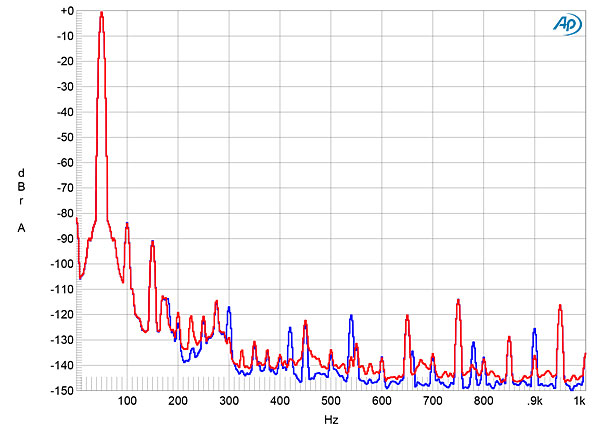

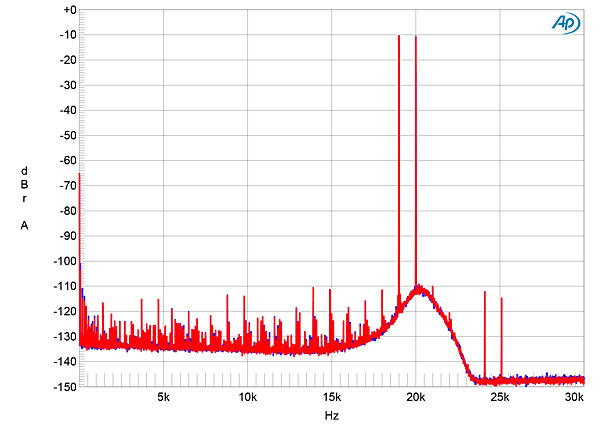
Finally, when I tested the Kalista DreamPlay One with 16-bit J-Test data (fig.12), the spectral spike that represents the high-level tone at exactly one-quarter the sample rate shows some spreading at its base, though the odd-order harmonics of the LSB-level, low-frequency squarewave are close to the correct levels (sloping green line). However, sidebands can be seen spaced at ±60, ±120, and ±180Hz, etc., these perhaps due to residual power-supply ripple present on the DAC chip's voltage reference pin.

Other than that, the Kalista DreamPlay One demonstrates good audio engineering.—John Atkinson

"Hello, Star Trek Enterprise here ........... How can we help you?"
"Ahoy ahoy, Alexander Graham Bell here .......... Beam me up Scotty"

May be a collector item for people with deep pockets :-) ...........

save for the shortage of transport spare parts; which is really a shame, since well designed cd players can wipe out almost anything out there sonically speaking.

I agree. A good cd based system playing decent recordings can deliver sonic tricks I've yet to hear elsewhere, save megabuck record players. Call me sheltered, considering I've yet to hear what high-bitrate downloads can do.

Really? I lasted about 30 seconds before I had to bail. Someone is in serious need of vocal lessons.

Not very good on the bench there JA. Kinda had to bite your tongue a bit in the conclusion.
And what with not getting digital inputs for this kind of money, that stinks.
Cheers George

Not sure why this kind of product is reviewed in Stereophile. I doubt that any potential purchaser even reads audio magazines, they are the type that relies strictly on the recommendation of the sales person. If it looks cool and is expensive, then it must be great. Anyone that cares even the slightest bit about measurements would not consider this player for even a second.

Not sure why this kind of product is reviewed in Stereophile.
I have just written an As We See It essay for the November issue on this subject. In the meantime, see my thoughts at www.stereophile.com/content/price-event-horizon.
John Atkinson
Editor, Stereophile

... the combination of an ineffective anti-aliasing filter and a rolled-off high frequency response - to impress a Stereophile reviewer?
Would the reviewer have been half as impressed if instead the unit was packaged in a relatively plain black box and the remote control was made of plastic?

You have revealed the secrets to success ........ Also add good looks :-) .............

Beauty is only skin deep ......... What is under the hood is what matters :-) ............

Looking at that bling-bling design, one can't help wondering of this review suffered from the expensive-wine-label-on-a-cheap bottle bias effect. (As JA's measurements seem at least in part to suggest).
If ever there was a review begging for blind test methodology, this would be it.

Perfect
Impulse
Response
AD came out and said it in the review, plus if you've read much of Art's stuff (and I'm sure you have) then you'd know what he values in a playback system.

... it radiates from the speakers AD is using, propagates through his listening room and finally reaches his ears?

what's the point of any of this? It's just going to get mangled by the speakers/amp/preamp/room/whatever anyway. yeah, you're right, let's all just get some cheap used Radio Shack speakers and a cheap Sansui receiver from the 80's and be done with it. smh.

... standard equipment in a 2001 Subaru:
https://www.stereophile.com/content/naim-cd555-cd-player-art-dudley-october-2007

"Don't review (audio) equipment with your eyes" ............ John Atkinson :-) .........

If you bought one of these, your photo should be next to the phrase in the dictionary, "more money than brains".
Yes, it's pretty, but it's performance no better than any disc player you can buy for 2.5% of its price. That it only plays CD's is stupefying.
This unit is absurd in the worst way.

Outstanding! works as always- AD
I enjoyed how you compared this player to your road-tested Sony ES spinner. I had no idea that the Philips CDM PRO12 transport was still in production? Which other brand(s) still incorporate this veteran transport into their spinner designs?

It's really fascinating that Art found such small differences in the filter settings. This is consistent with some other observers trying different filter shapes in other systems. Other factors in the player and system characteristics are probably more of a factor in the overall experience. But, a difference is a difference.
Still, how does this square with the night and day differences some observers are reporting with MQA processed recordings?

the primary role of digital filtering is very similar to that of the analog subsonic filters of yore – namely safety concerns about the subsequent equipment; amplifier topology/bandwidth and tweeter frequency extension/power handling should be the main factors in digital filtering selection. From a purely (ultra)sonic point of view, save for possible intermodulation by-products, no low-pass filter is required whatsoever.

It's a ROLEX kind of product, isn't it?
Maybe a ROLEX Presidential extravagance expressly for people like our own Agent Orange in Washington.
I have to admit that I'd love to own and "Show-off" all that Chord Stuff that's so darn striking and industrially beautiful, who wouldn't ?
Back in the Day, I kept a Gold Mitchel Gyrodek in my Esoteric Audio Store Front Window.
If you love your Audio Gear more than your Wife, this CD Player is a dam good way to prove it.
However, now-a-days, I'm rather inclined to the LG Phone method of Audio advancement and rely on a Porsche 718 Hybrid for showing off.
I'm not showing off, I'm investing in my Grandchildren's future Quality of Life.
I vote for the PS Audio Player
Tony in Michigan
ps. it does make for one hell of a Front Cover !!!

it does make for one hell of a Front Cover !!!
Indeed it does. Again this is something I write about in the November issue's As We See It.
John Atkinson
Editor, Stereophile

Another "Must Read" from Stereophile.
Tony in Michigan

As someone who worked in the magazine business for 16 years - TIme Inc. - and who intimately involved in the choice of covers, I look forward to reading your November column. In a nutshell, for a magazine cover, you strive to make 'eye candy" and make things look larger than life.

which traditional print magazines saw the internet coming and took action (whether it was successfull or not is a different issue - Stereophile seems to have done okay, others less so) and which were just caught totally off guard.

The bulk –if ever was one– of unnecessarily expensive US/EU-made audio gear is actually being sold to Asian markets; opposite is the trade route case for plebeian electronics..

Noone can say, you didn't: "I asked—no, begged—for the opportunity to write about the DreamPlay One. "
I'm shure you enjoyed listening as writing the advertisement.

Stereophile could come up with an yearly calendar (just like Sports Illustrated swimsuit issue) with exotic, good looking audio equipment :-) ...........

That is so great, you deserve royalties.

I will be happy with free life time subscription to Stereophile including the yearly calendar :-) .......

"the maximum balanced output level was twice the unbalanced, at 4.92V"
The peak in Fig 1 is over 1V higher than this - might it make music more dynamic than the digital representation or is it that it can't sustain it's true max during the max output test?

"the maximum balanced output level was twice the unbalanced, at 4.92V" The peak in Fig 1 is over 1V higher than this...
The maximum output level is an RMS figure, which is lower than the peak; 3dB lower for a sinewave. The Kalista's peak output voltage is therefore just under 7V, so there's no conflict between the two voltages.
John Atkinson
Editor, Stereophile

Stereophle could probably re-publish some of the articles published in the 90s and early 2000s ....... like the article comparing AAC, Mp3 and CD quality sound as well as 'Quality lies in the details' on the Stereophile website .........

Stereophile could probably re-publish some of the articles published in the 90s and early 2000s ....... like the article comparing AAC, Mp3 and CD quality sound as well as 'Quality lies in the details' on the Stereophile website ........
The Features and Reference sections of our website archives - see links at the foot of every page - have almost all the technical articles we have published over the years. You can sort them by title, date of being posted, or date of original publication. You can also use our search engine in the menu bar at the top of every page.
For example, if you enter the phrase (in double quotes) "Quality Lies in the Details" in the search magazine, all the pages of the article can be found at www.stereophile.com/features/112/index.html.
John Atkinson
Editor, Stereophile

Mr Atkinson,
I'd like to express my admiration, and thanks, for your product, in print and especially on line. This Stereophile is so well presented in terms of graphic style, organization, and ease of use. No squinting at low contrast text on ridiculously colored backgrounds. It's easy to find exactly the content I want (specs, measurements etc always there at the bottom of the page). This is probably the most consistently pleasant site to read that I routinely visit.
(That goes for the magazine as well - I'm a digital subscriber and sometimes still pick up the print version).

Thanks JA ........ Another interesting and informative article to read .......... three part series of "loudspeaker measurements" ..........

"Always pass on what you have learned" ........ Yoda :-) .............

Stereophile published an article in 1995 about similar topics like output voltages etc ......... The article was written by Robert Harley with contributions by JA .......... I found that article on Google search ........

That costs more than any of my first 3 houses. And it is not the best C D player ever made?? Wow! I am so glad JA tests things.

Thank you JA for testing and measuring the audio equipment ............

There is an audio hall of fame for audio equipment .......... I am not sure if there is an audio hall of fame for people ...... If there is such an audio hall of fame for individuals, JA is eminently qualified as an inductee .......

I know I'm not in the market for $45,000.00 of digital replay. That said, I'm always interested in assaults on the state of the art. In one regard this Blingy collection of audio objects appears to be SOTA. The impulse test, without ringing fore or aft, appears perfect. Art Dudley liked the player best with the slow roll-off filter, the mode that produces that perfect impulse test. I think there's something to that.
However, the product is prima-facie absurd.
This is my wish list for a disc spinner in the 21st century. First, it has to play everything. As physical products are preterite, they will have to be treated as "special cases" from here on out. Second, I would want all the disc data moved to a solid state memory. I would use the data from the SSD instead of the disc drive. I would design the disc player/storage locker to be accessible to DAPs so one could smoothly and easily move sound files to the DAP. I would separate the disc drive/"storage locker" from the DAC. I would include HDMI as an output option for obvious reasons. The DACs I'd come up with would come in "Plain"—just 2 channels output, no bells & whistles—& "Peanut", with streaming options built in. There would also be a "Surround" flavour. All the DACs would have USB and HDMI inputs in addition to the usual suspects.
I could imagine a $45,000.00 version of some combination of these boxes making sense. But a $45,000.00 CD player that only plays CDs? Pricey bling.

... the CD player that was standard equipment in a 2001 Subaru?
Anywhere near as perfect as that from the Kalista? Probably not.
Yet that CD player in the Subaru was able to move AD "close to tears" as related here:
https://www.stereophile.com/content/naim-cd555-cd-player-art-dudley-october-2007
Are you still certain that the nearly perfect impulse response was the key factor that made AD so highly rate the sound reproduction from the Kalista?

Seriously guys,
Just because the impulse response is of short duration, or have no pre-ringing IMO are not characteristics that tell us if the filter is "perfect". More myth-making in the audiophile press IMO. In fact, I would argue that it should be the opposite for high fidelity.
Anyhow, as a start, perhaps someone should show us where pre-ringing shows up in some actual music and under what circumstances. Once that is demonstrated, then maybe we can get somewhere with actual understanding of what is or is not desirable as far as impulse responses go.

..though the same could also be the case with harmonic distortion, which is definitely part of "real" music one way or another; certain electronic distortion patterns could actually compensate for harmonics that have been altered or lost in the recording proccess, couldn't they?

They could, but of course, the electronics would have to be some sort of "thinking machine" for that sort of task. As it is, tubeaholics settle for second harmonic distortion ladled on like so much gravy.
On the other hand, lack of ringing fore and aft suggests that something is being done right.
Tubes are for folks who can't face reality. Drugs are for people who can't stand solid state.
I think I'm done here.

that despite all “distortion pride” tube tech, I still cannot reliably tell tubes from solid state (or class A from class D or..) merely by hearing. Individuality counts more than race in audio as well as in people. No, it’s not distortion – must be the lighting of the lamps..

One of the interesting details about the audio engineering field over the past decades is the advances in measurement capabilities. Through clever design and better components, it's now possible to measure harmonic distortion down to -120 dBC or lower. That's pretty much like being able to hear the foot steps of an ant walking across the stage in front of the monitors at a Led Zeppelin concert of the 70's.
Some of this has been attained through techniques such as waveform averaging over many "sweeps" of the desired measurement band. Really amazing stuff.
What really has not progressed much is new measurements that give better insight into the details of complex modulation - aka musical content - and the fidelity to the source. To hit on averaging again, it may be that averaging actually masks the real thing to measure - events that take place differently in each sample period. That sort of thing has been examined in other areas of electronics, but has been pretty much ignored in audio.
Why is that? Does nobody care? Is arguing more fun?
That's not even taking into account how the human auditory system might perceive sound. Pretty much everybody knows there's plenty of stops along the recording chain where the program content is modified to make it sound "better". Whether it's compression or changing the mix, that's a distortion of the original. That pretty much says that perfect fidelity is not what people perceive to be best, right?
As for the perfect impulse measurement, yeah, you don't find perfect impulses in the real world of music. It may not even be that a perfect impulse is what is truly important. Instead, it may well be that, by chance, a filter that reproduces an artificial pulse well conditions the sound in a way that people find to be more pleasing or more realistic. Who knows - maybe alias products are a desirable thing with regard to how people perceive sound. This test might have uncovered something that it wasn't designed for. It would hardly be the first discovery of that nature - I think of Jansky and cosmic noise.
My point is that I don't think anybody really has a good handle on this. The existing dogma of THD (c'mon; sound is composed of lots of tones taking place all at once - there is far more IMD power than harmonic power in an imperfect system) may be an important condition, but it hardly tells the whole story. I'm not going to pick on the audio press for that. They may not be offering a resolution, but neither is anybody else. The BBC tried very hard back a few decades ago and got nowhere. Who's to blame? Better yet, who's going to make progress that people won't spend man-centuries arguing over?

Over the top audio bling with a nouveau riche design sensibility. The audio equivalent of a McMansion.

Test it playing CDs against the corresponding vinyl release (using originally analogue recordings of course) on any decent ~ $3k turntable. Then, tell your readers on the basis of sound-quality whether they wouldn't be better off buying that turntable and $40,000 of Mint vinyl. I gave my entire CD collection to goodwill for this very reason and am currently rebuilding my vinyl collection. This comparison should be made every time such super-expensive digital audio is gushed over in a magazine ostensibly dedicated to audiophilia...

unabashedly contemplative comments based on purely impersonal interest for someone else’s hard earned blood money ;-)

From the review ...
"Clauzel said that the Elektra also contains 'specific ultra-low-noise regulation'dedicated to the player's DACs—a dual-mono pair of Asahi Kasei Microdevices AK4497 chips, implemented without digital oversampling."
This does not make sense. The AK4497 DAC is a delta-sigma design. It HAS to use digital filtering (oversampling). Nowhere in its datasheet does it mention non-oversampling.
The datasheet does note:
"six different digital filter types are selectable according to the user audio and system preferences."
Refs:
https://www.akm.com/akm/en/product/datasheet1/?partno=AK4497EQ


this reviewer is delusional. CD players do not have "sound quality" This review is the reason the audio press is a laughingstock. What is it that this fool doesn't understand about one's and zero's? Every correctly designed modern CD player sounds EXACTLY the same.

Too bad they don't make any of these "correctly designed modern CD players" anymore. Ah . . . the good old days . . .

this reviewer is delusional. CD players do not have "sound quality" This review is the reason the audio press is a laughingstock.
If that is the case, Mr. Harper, then why do you read Stereophile? If you don't do so, then why are you posting to our site? You are like a Protestant posting to a Catholic website that transubstantiation is a fraud, that the wafer and wine in the communion chalice are just that, ie, you are a troll.
John Atkinson
Editor, Stereophile

"You are like a Protestant posting to a Catholic website that transubstantiation is a fraud, that the wafer and wine in the communion chalice are just that..."
I was raised Catholic, then escaped in 1st grade. I have none of the faith but all of the shame/guilt; so, call me a genetic Catholic!
Anyways...
I was once involved in a case of food hypersensitivity that orbited this very issue. The victim was a young girl, a devout Catholic, who was going to have her first communion. She was exquisitely sensitivity to wheat/gluten and her parents had discovered that the 'host' was made from bread (sanctified Wonder Bread without crust, then pressed and dried.) At issue was a request they had made for an alternative gluten free 'host.'
The church, being the church, had refused this request, but the parents were going to bring suit. I was called to verify the child's sensitivity and testifying was a great deal of fun...
The underlying paradox that we presented the church:
The Catholic Church asserts that consecrated bread and wine are not merely "symbols" of the body and blood of Christ: they are literally the body and blood of Christ. It also declares that, although the bread and wine completely cease to be bread and wine (having become the body and blood of Christ), the appearances (the "species" or look) remain unchanged, and the properties of the appearances also remain (one can be drunk with the appearance of wine despite it only being an appearance).
So, looks like bread and wine, but has actually been divinely transmorgrified into the actual body and circulatory fluids of Christ.
Therefore, no need to accommodate this child.
Our position: If she was sensitive to gluten and took communion in 'good faith' and had an untoward reaction, then that would be 'proof' that transubstantiated 'host' is not, in fact, made up of authentic Christ parts. Either that, or, it would show she had an immune mediated intolerance to the body of Christ, which would be quite a coincidence that she'd be adversely affected by the body of her Savior and by wheat/gluten.
It seemed to be lose/lose for the church, and the family was ready to take it tho the TV news channels. I thought it would be a hoot to testify regarding these ramifications under oath, "so help me, God."
At the 11th hour, the local parish priest saved the bishop's bacon, and, on the sly, the family was allowed to prepare their own host, and then he would sanctify it....all agreeing not to let the higher ups in the church know what the compromise was. That way, one fewer kid harmed by the Catholic Church!
After all, it shouldn't matter what substance the host started out as. Only to the bishop on up, I guess.
So, cue happy ending music on the pipe organ, theologically vast question postponed!
_
As you ponder it, if the sanctified host was truly the blood and body of Christ, wouldn't it be awesome to use for transplants and transfusions?
_
So, much thread drift, but JA brought up a very cool theological topic!
Cheers, JA!

What a great story, Anton!
The test you proposed seemed as unwelcome by the church as blind testing is unwelcome by reviewers and audiophiles. And...perhaps....for similar reasons ;-)

Can you tell me that date upon which commenced all correctly designed CD players henceforth sound exactly the same?
That would be useful to know.
Do you know which model started this? Finding the first correctly designed CD player would be cool, for history.
Also, any list you'd care to provide would help. Could save a lot of money!
Your information will be invaluable to the audio community!
Thank you for speaking up, I look forward to using your information.

"Perfection is not attainable, but if we chase perfection, we can catch excellence" ......... Vince Lombardi :-) .............

I read in the latest edition of the Sound & Vision magazine that, some automakers are not including CD players in some of their latest models (sad) ............

I have, in fact, posted to catholic websites (after having been a catholic for twenty years) and presented logical,factual, historically based arguments which challenge certain catholic doctrines,such as the perpetual virginity of Mary. I don't think that makes me a troll.If that were true it would lead logically to the conclusion that no one should ever be permitted to challenge the status quo. Your example of the transubstantiation and communion are not analogous in this comparison because those things are purely articles of faith. They can not be proven or disproven. But it can be proven, using biblical and historical references,that Jesus had brothers and sisters.His brother James founded the Jerusalem church. I will admit that my post was disrespectful and antagonistic.I apologize for that. I should have made a more nuanced argument.

There's no proof to be made here about brothers, sisters or aunts of Jesus. There no definitive proof of the existence of Jesus as a historical figure. There are many writings that contradict what you are saying. Just because they were thrown out of earlier drafts of what was to eventually become what we call the Bible, doesn't in any way make those contradictory writings any more or less meaningful than the unprovable contents of the final, massaged and edited product. Which is still being massaged and edited. If you know anything about how the bible was made up, you'll know it was made up. By humans. With obvious agendas.

and ethical improvement of her children a mother had given them Aesop’s fables to read. Too soon however they returned her the book while the eldest, wise well beyond his years, expressed himself as follows: “This is no book for us! It is far too childish and stupid – no longer can we be made to believe that foxes, wolves and ravens can speak; we have long since got beyond that stuff!”
..Who does not recognize in these young hopefuls the enlightened rationalists of the future?
Arthur Schopenhauer, Parerga and Paralipomena, 1851.

Nuance?
It's insulting.
You can't unread what you wrote here.

"Only two things are infinite .......... The universe and human stupidity ........... I am not sure about the former" ........... Albert Einstein .........

"The difference between stupidity and genius is that, genius has its limits" .......... Albert Einstein ........

one more time; it was about 15 or 20 years ago that CD players became essentially perfect in their reading and transmission of a digital binary number stream. This means that if the player is outputting a digital signal to an external DAC, then they will all sound the same.I understand the compulsion of those who have spent thousands on a CD player to defend their purchase.They're mitigating buyers remorse.I also spent more than necessary.I bought an OPPO 203. I bought it for it's physical build quality.Cheap players usually don't last very long.

... why this CD player got such an enthusiastic review from Stereophile, and for that matter its sister publication HFN/RR, when the frequency response reported by both publication rolls off like a cassette recorder with cheap tape.
I’m not immune to the idea of spendy CD players (I own one that was class-A-rated by Stereophile when it was in production, and incidentally has a flat response) but this is just ridiculous.

Perhaps the most common topic of discussion at shows is, “Who has the best sound?” Consumers are looking to be wowed as are reviewers. Awards are given and reputations are made. New technology trickles down to more “affordable” products, but inevitably, the things that differentiate the top components from their lesser siblings are the costly bits: the more robust power supply, the extra isolation, the added mass and machining, the larger more expensive drivers, etc. If all components were equal and their sole value was in their utility, then we could all stay home and none of this would be necessary. Should manufacturers cease to push the envelope? Should price limits be imposed? Should designers leave their creativity behind? Finally, would Stereophile be doing its readers a service or disservice if it ignored high dollar state-of-the-art components?